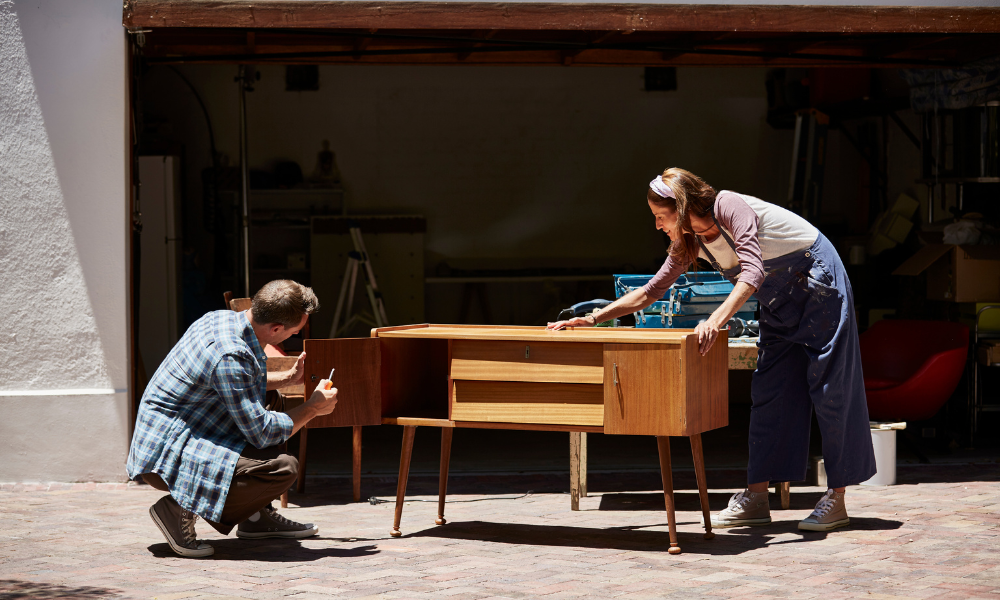If you have an eye for design and a knack for finding hidden treasures, furniture flipping may be an awesome way to make some extra cash. Not only can it satisfy your creative cravings, but it can also be a lucrative business opportunity. In this article, we will guide you through the exciting world of furniture flipping in seven steps and show you how to turn your passion into profit.
1. Find Your Treasure Trove
The first step to successful furniture flipping is finding your hidden gems. Keep your eyes peeled because you never know what diamond in the rough you might stumble upon! Look for pieces with good bones, even if they are worn or outdated. Remember, your creativity will breathe new life into them. Here are three tips to help you find furniture to flip:
- Research and scout local sources: Start by researching and identifying local sources where you can find furniture at affordable prices. This can include thrift stores, garage sales, estate sales, online marketplaces, or even curbside pickups. Visit these places regularly and keep an eye out for pieces that have potential for improvement.
- Look for quality and potential: When searching for furniture to flip, focus on finding pieces with good structural integrity and the potential for improvement. Look for solid wood furniture as it tends to be more durable and can be refinished easily. Avoid items with major structural damage, as repairing them might not be cost-effective. Instead, focus on pieces that need cosmetic improvements, such as refinishing, reupholstering, or painting. Always try to assess the potential resale value of each piece before making a purchase.
- Negotiate prices and be cost-conscious: Negotiating prices is crucial when flipping furniture. Most sellers expect some haggling, especially at garage sales or flea markets. Be prepared to make reasonable offers and negotiate a price that allows for a profitable flip. Make sure to consider your budget for materials, such as paint, fabric, or hardware, needed for the refurbishment. Ensure that the total investment, including purchase price and refurbishment costs, doesn’t exceed the potential resale value. Being mindful of costs will help maximize your profit margins.
2. Let Your Imagination Run Wild
This is the fun part. Once you have your furniture piece, it’s time to unleash your creativity. Let your imagination run wild! Consider the style, color scheme, and purpose of the piece. Will it become a shabby-chic dresser, a boho-inspired coffee table, or a sleek modern chair? Don’t be afraid to experiment with different techniques such as painting, staining, or reupholstering. The sky’s the limit when it comes to transforming your find into a unique masterpiece.
3. Quality Matters
While creativity is key, it’s important not to overlook quality. Taking shortcuts might save you money upfront, but it can compromise the overall look and durability of your piece. Remember, you want your customers to be impressed by your work and willing to pay a premium price for it. Here are some great tips for quality pieces:
- Prepare and repair: Before starting any refinishing or refurbishment work, thoroughly clean the furniture to remove dirt, grime, and old finishes. Repair any structural issues, such as loose joints or broken parts. Ensure that the piece is stable and sturdy before moving forward with the makeover.
- Choose quality materials: Invest in high-quality materials to achieve a professional and durable finish. Select paints, stains, varnishes, or finishes that are specifically designed for furniture restoration. Opt for durable upholstery fabrics that can withstand wear and tear. Using quality materials not only enhances the appearance of the furniture but also increases its longevity and value.
- Pay attention to detail: The success of a furniture flip often lies in the details. Take the time to carefully sand the surfaces to ensure a smooth finish. Apply multiple thin coats of paint or stain, allowing each coat to dry completely before applying the next. Pay attention to details like decorative accents, knobs, or handles. Replacing worn or outdated hardware with stylish and modern options can significantly elevate the overall look of the piece. Additionally, ensure that upholstery work is neat and professional-looking, with clean lines and secure attachment.
4. Price It Right
Determining the right price for your flipped furniture can be tricky. You want to make a profit, but you also need to be competitive in the market. Research similar items online or visit local furniture stores to get a sense of the pricing range. Consider the amount of time, effort, and materials you put into the piece. Don’t undervalue your work, but also be mindful of setting prices too high, as it may deter potential buyers.
5. Market Your Masterpieces
Now that you have a stunning piece ready to sell, it’s time to spread the word. Here is how to market your masterpieces:
- High-Quality Photography: Good photography can significantly enhance the appeal of your pieces and attract potential buyers. Use good lighting, a clean background, and multiple angles to showcase the furniture’s features and craftsmanship. Ensure that the colors and details are accurately represented in the photos. Consider staging the furniture in a well-designed setting to help customers envision it in their own spaces.
- Online Platforms and Social Media: Utilize online platforms and social media to market your flipped furniture. Create listings on popular online marketplaces such as Etsy, eBay, or Facebook Marketplace. Write compelling descriptions that highlight the unique aspects, quality, and refurbishment of each piece. Use relevant keywords to improve search visibility. Share captivating photos of your furniture, engage with potential customers, and use relevant hashtags to expand your reach.
- Build a Website or Portfolio: Consider creating a website or portfolio to showcase your flipped furniture and establish a professional online presence. A dedicated website allows you to showcase your work, tell your story, and provide more detailed information about your services. Include high-quality images, descriptions, pricing, and contact information. You can also incorporate customer testimonials or before-and-after transformations to build credibility. A website serves as a centralized hub for your business, helps attract organic traffic, and allows potential customers to browse and inquire about your furniture at their convenience.
6. Provide Excellent Customer Service
Customer satisfaction is key to building a successful furniture-flipping business. Be responsive to inquiries and maintain clear communication with your potential buyers. Offer flexible delivery options or provide a space for customers to view and test your furniture. Going the extra mile to ensure a positive experience will not only generate repeat business but also valuable word-of-mouth referrals. Satisfied customers are more likely to recommend your services and become repeat buyers, contributing to the success and growth of your venture.
7. Learn from Experience
As you gain more experience in the furniture flipping world, don’t be afraid to learn from your successes and failures. Take note of what sells well, what trends are popular, and what techniques yield the best results. Continuously improve your skills and adapt to market demands. Attend workshops, join online forums, and connect with fellow furniture flippers to share knowledge and gain inspiration. Remember that you aren’t going to sell every piece you do overnight. Furniture flipping takes some skill but from experience, you can have it!
Furniture-flipping is not only about making money; it’s also about unleashing your creativity and passion. You get to embrace the joy of transforming forgotten pieces into stunning works of art. With dedication, a keen eye, and a sprinkle of imagination, you’ll be well on your way to turning your furniture flipping hobby into a profitable and fulfilling business. Happy flipping!











